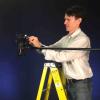-
Posts
26 -
Joined
-
Last visited
Profile Information
-
Occupation
Editor
-
Location
Los Angeles
-

FS: Konova Camera Slider Dolly K2 100cm (39.4 Inch)
Andrew Payne replied to Andrew Payne's topic in Cine Marketplace
Bump -

FS: Konova Camera Slider Dolly K2 100cm (39.4 Inch)
Andrew Payne replied to Andrew Payne's topic in Cine Marketplace
Bump $150 -
Bump
-

FS: Konova Camera Slider Dolly K2 100cm (39.4 Inch)
Andrew Payne replied to Andrew Payne's topic in Cine Marketplace
Bump -
I'm selling this Konova slider. It's the 100cm version. You can find the Benro head I used with it in a separate listing. It's a really cool and light-weight slider. I found it worked well mounted to two light stands with thread adapters. $190
-
I'm selling this Benro head that I bought and used on a slider a few times. $130
-
Sold
-
This is my used Sola 4. It's about the power of an ARRI 300, but it's really quiet and runs cool. Asking $350.
-
Phil, Nikon made a bunch of wides that remain expensive, but some may be found reasonably priced. The really wide 14mm and 15mm are probably more expensive than what you found. There was an 18mm 3.5 that's about the same price as the f/4. There's a 20mm f/2.8, a 20mm f/3.5, and a 20mm f/4 that are all progressively less expensive. There was also a 24mm f/2 and a 24mm f/2.8, but those may be harder to find and too close to your 28mm in any event.
-

Contributing factors to the pacing in modern film?
Andrew Payne replied to Max Field's topic in General Discussion
Thanks for posting this. Very interesting article and research. -

Woody Allen
Andrew Payne replied to Alexandros Angelopoulos Apostolos's topic in In Production / Behind the Scenes
I'm interested in seeing what this looks like too; amongst the criticisms of the film are some caveats that it does look lovely. It's only on one screen in LA so it may be a blu-ray down the road for me.- 5 replies
-
- Woody Allen
- Vittorio Storaro
-
(and 1 more)
Tagged with:
-

Home Movie Cameras in 1971 Question
Andrew Payne replied to Sarah Beauchemin's topic in General Discussion
I don't know if you're committed to a film camera, but there were early consumer video cameras available at the time (albeit the high end consumer market). 1971 predates VHS, so these devices recorded to open-reel video tape, and were capable of 20 minutes and longer. The cameras were medium sized. The recorders were big, but could be placed away from the camera since they were connected by cables. Plus as video cameras, they required no developing of film. This is what they looked like: -

Best Cinematography You've Seen In A Comedy?
Andrew Payne replied to Max Field's topic in General Discussion
Comedy often is lit very evenly avoiding shadows and contrast. Compare this to say, a crime drama which might have strong contrast, shadows and subdued or gloomy colors. The traditional thinking is that shadows and darkness symbolize mystery and danger, and presumably evoke feelings of fear, isolation and sadness. The goal with comedy is normally the opposite. Rather it's to create a cheerful setting, reduce anxiety, and set the mood for laughter. I don't think there are rules, and there are many great exceptions where comedies have used more dramatic lighting with very funny results. But that's the basic idea. -

Is cinematograpfy these days too perfect?
Andrew Payne replied to Alan Kovarik's topic in General Discussion
It's here: -

Getting enough work & the next level.
Andrew Payne replied to Nick Morr's topic in Jobs, Resumes, and Reels
I'm always baffled when production companies and others refuse to discuss rates. They ask for your rate, already knowing perfectly well what they want to pay, and if you don't magically hit their number through clairvoyance, they move on to the next guy and play the same game all over again. I'm on both sides of this scenario, because I frequently hire crew for productions. I always ask rates, and if I can't make their numbers, I tell them what I can pay and we negotiate. It's not complicated. I think this is the perception, but it's not an accurate model. For one thing, it's not the norm for ad agencies and corporate clients to see line-by-line crew budgets. Thus a DP's rate - unless you're very famous and expensive - will not be billed back in this way. You're bundled in with other costs. In terms of markup, doubling all the crew rates would be great but is not prevalent. It's much less. And budgets are made before the crew is hired, so the higher your DP's rate, the less you make on that line. Maybe you really want a particular DP and you don't make much on their line at all.



